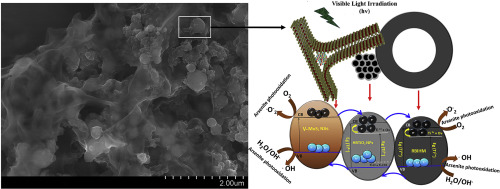Composites Part B: Engineering ( IF 13.1 ) Pub Date : 2020-01-20 , DOI: 10.1016/j.compositesb.2020.107785 Ali Balati , Akanksha Matta , Kelly Nash , Heather J. Shipley

|
In this research, Black TiO2 (BTiO2), which consisted of Rutile Based Inorganic Hollow Microspheres (RBIHM) and hydrogenated anatase TiO2 nanoparticles, decorated with MoS2 nanosheets (HBTiO2/RBIHM-MoS2 photocatalyst) was synthesized using Pulsed Laser Ablation in Liquid (PLAL) followed by microwave irradiation. Formation of vertically aligned MoS2 nanosheets, RBIHM and HBTiO2 nanoparticles were confirmed by different characterization techniques. The spectroscopic analysis revealed phase transitions in HBTiO2/RBIHM nano and microstructures along with the formation of different crystal disorders such as amorphous layers, oxygen vacancies, trivalent titanium ions and formation of molybdenum oxide (MoO3-x) in MoS2. In addition, MoS2 films in HBTiO2/RBIHM-MoS2 nanocomposite showed both Mo5+ and Mo6+ oxidation state, which was inferred that these films have a p-type conductive behavior. Furthermore, the interconnected layers of MoS2 nanosheets led to the formation of a porous like 3D nanostructure in HBTiO2/RBIHM-MoS2, which could significantly improve its photocatalytic performance. Arsenite photooxidation efficiencies of 70.3% and 96.6% and arsenate adsorption capacities of 1600 and 5200 μg g−1 were obtained for HBTiO2/RBIHM and HBTiO2/RBIHM-MoS2, respectively. The synergetic effects originated from making RBIHM-HBTiO2, RBIHM-MoS2 and MoS2–HBTiO2 heterojunctions along with the surface and morphology modification in MoS2 NSs and HBTiO2/RBIHM can explain the nanocomposite superior photocatalytic performance. The present work can trigger a broad interest in the cost-effective nanoarchitecture of visible light driven heterostructured photocatalysts.
中文翻译:

垂直排列的MoS 2层与氢化黑TiO 2和金红石型无机空心微球的异质结,可大大增强可见光砷的光氧化作用
本研究利用脉冲激光合成了由金红石型无机空心微球(RBIHM)和氢化锐钛矿型TiO 2纳米颗粒组成的黑色TiO 2(BTiO 2),装饰有MoS 2纳米片(HBTiO 2 / RBIHM-MoS 2光催化剂)。液体烧蚀(PLAL),然后进行微波辐照。通过不同的表征技术证实了垂直排列的MoS 2纳米片,RBIMM和HBTiO 2纳米片的形成。光谱分析揭示了HBTiO 2中的相变/ RBIHM纳米和微观结构,以及形成不同的晶体紊乱,例如非晶层,氧空位,三价钛离子以及在MoS 2中形成氧化钼(MoO 3-x)。此外,HBTiO 2 / RBIHM-MoS 2纳米复合材料中的MoS 2膜同时显示Mo 5+和Mo 6+的氧化态,推测这些膜具有p型导电行为。此外,MoS 2纳米片的互连层导致在HBTiO 2 / RBIHM-MoS 2中形成类似多孔的3D纳米结构,可以显着提高其光催化性能。对于HBTiO 2 / RBIHM和HBTiO 2 / RBIHM-MoS 2,砷的光氧化效率分别为70.3%和96.6%,砷的吸附容量为1600和5200μgg -1。协同效应源于在MoS 2 NSs和HBTiO 2中使RBIHM-HBTiO 2,RBIHM-MoS 2和MoS 2 -HBTiO 2异质结以及表面和形态改性/ RBIHM可以解释纳米复合材料优异的光催化性能。当前的工作可以引起对可见光驱动的异质结构光催化剂的具有成本效益的纳米结构的广泛兴趣。



























 京公网安备 11010802027423号
京公网安备 11010802027423号